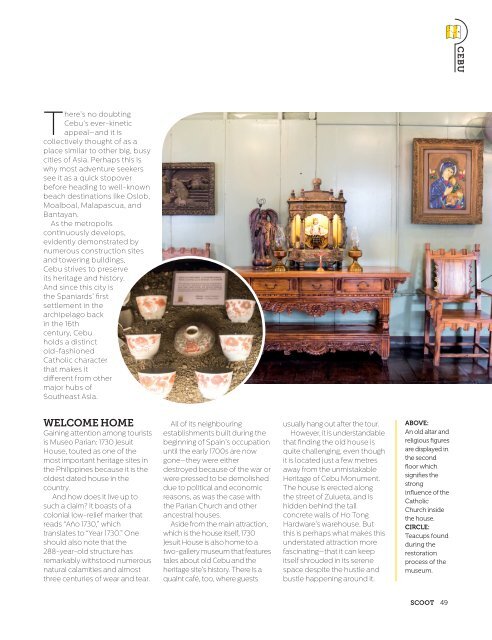July 2018 - Scoot In-flight Magazine
You also want an ePaper? Increase the reach of your titles
YUMPU automatically turns print PDFs into web optimized ePapers that Google loves.
CEBU<br />
There’s no doubting<br />
Cebu’s ever-kinetic<br />
appeal—and it is<br />
collectively thought of as a<br />
place similar to other big, busy<br />
cities of Asia. Perhaps this is<br />
why most adventure seekers<br />
see it as a quick stopover<br />
before heading to well-known<br />
beach destinations like Oslob,<br />
Moalboal, Malapascua, and<br />
Bantayan.<br />
As the metropolis<br />
continuously develops,<br />
evidently demonstrated by<br />
numerous construction sites<br />
and towering buildings,<br />
Cebu strives to preserve<br />
its heritage and history.<br />
And since this city is<br />
the Spaniards’ first<br />
settlement in the<br />
archipelago back<br />
in the 16th<br />
century, Cebu<br />
holds a distinct<br />
old-fashioned<br />
Catholic character<br />
that makes it<br />
different from other<br />
major hubs of<br />
Southeast Asia.<br />
WELCOME HOME<br />
Gaining attention among tourists<br />
is Museo Parian: 1730 Jesuit<br />
House, touted as one of the<br />
most important heritage sites in<br />
the Philippines because it is the<br />
oldest dated house in the<br />
country.<br />
And how does it live up to<br />
such a claim? It boasts of a<br />
colonial low-relief marker that<br />
reads “Año 1730,” which<br />
translates to “Year 1730.” One<br />
should also note that the<br />
288-year-old structure has<br />
remarkably withstood numerous<br />
natural calamities and almost<br />
three centuries of wear and tear.<br />
All of its neighbouring<br />
establishments built during the<br />
beginning of Spain’s occupation<br />
until the early 1700s are now<br />
gone—they were either<br />
destroyed because of the war or<br />
were pressed to be demolished<br />
due to political and economic<br />
reasons, as was the case with<br />
the Parian Church and other<br />
ancestral houses.<br />
Aside from the main attraction,<br />
which is the house itself, 1730<br />
Jesuit House is also home to a<br />
two-gallery museum that features<br />
tales about old Cebu and the<br />
heritage site’s history. There is a<br />
quaint café, too, where guests<br />
usually hang out after the tour.<br />
However, it is understandable<br />
that finding the old house is<br />
quite challenging, even though<br />
it is located just a few metres<br />
away from the unmistakable<br />
Heritage of Cebu Monument.<br />
The house is erected along<br />
the street of Zulueta, and is<br />
hidden behind the tall<br />
concrete walls of Ho Tong<br />
Hardware’s warehouse. But<br />
this is perhaps what makes this<br />
understated attraction more<br />
fascinating—that it can keep<br />
itself shrouded in its serene<br />
space despite the hustle and<br />
bustle happening around it.<br />
ABOVE:<br />
An old altar and<br />
religious figures<br />
are displayed in<br />
the second<br />
floor which<br />
signifies the<br />
strong<br />
influence of the<br />
Catholic<br />
Church inside<br />
the house.<br />
CIRCLE:<br />
Teacups found<br />
during the<br />
restoration<br />
process of the<br />
museum.<br />
SCOOT<br />
49










